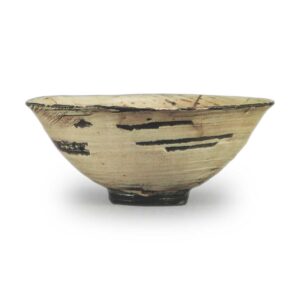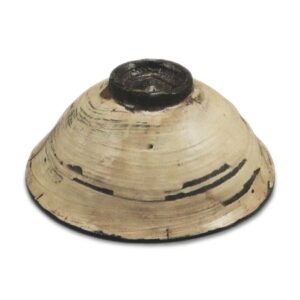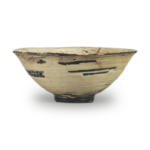

Height: 5.2-5.6cm
Diameter: 12.7cm
Height of foot ring: 4.0cm
Height of foot ring: 0.9cm
This is a famous brush-stroke bowl that has been passed down in the Hirase family of Osaka, and it is called “Goho” after the nickname for the pearl, because of its beautiful, white skin.
The name “Goho” is the same as “Goupo”, and in the “Meng Zang Biography” in the “Later Han History” it says “The former governor was greedy and the pearls left the area, but when the new governor arrived, the pearls returned”. There is also a song called “Gappo” in the Noh play, and in it, a fish spirit called Same-nin appears at Gappo-no-ura and gives the people of the village a jewel that is actually the tears of the fish spirit. The jewel is said to be a treasure that will grant long life and good health, and the fish spirit then returns after offering its congratulations.
Hakeme ware was produced in the early years of the Yi Dynasty in the southern part of Korea, and some of it was made in the same kilns as Mishima ware, while others were produced in kilns that only made Hakeme ware. There are countless Hakeme ware pieces that have been excavated in recent years, and some of them have even made their way to Japan, but there are not many that have survived to the present day, and Gaho is particularly well known as a masterpiece. However, it is still not clear today where this piece was made. The shape, especially the rim, is similar to the brush marks of the Goryongsan ware at first glance, but the foot ring is different, and it is not a sand-textured foot ring like the Goryongsan ware. There are five foot rings and four eye marks on the inside. The clay is more viscous than that of the Goryongsan ware, and it contains more iron. The white slip applied with a brush is thicker than that of the Goryongsan ware. It is thought that this is a brushwork from the Gyeongsang region, but it is not yet possible to say exactly where it is from.
The clay is a sticky clay with a high iron content that contains little sand, and the shape is a shallow bowl with a slightly flared rim. The inside and outside are covered in thick white clay, but on the outside there are several places where the clay has flaked off due to the thick coating, revealing the black clay underneath. The rim is also almost completely flaked off, revealing the black clay underneath. There is no white slip on the foot ring, and the foot ring is a type called kabuto-kin, with the foot ring standing up in the center. The entire surface is covered with a transparent white glaze, and there are some coarse cracks, but they are not very noticeable.
There are two wide channels and three narrow channels around the rim, and there are also some cracks in the body that were caused by the kiln, which have been repaired with lacquer. The clay is black, and the white clay that has been brushed on is almost pure white, giving the impression of being clear and vivid. The inside has been used a lot, and there are places where the rain leaks in, adding to the atmosphere, and the thickly glazed areas on the outside have a bluish tinge, indicating that it was fired in a reducing flame.
The bag is made of satin damask, and the inner box is plain paulownia wood with no writing on it. The outer box is also plain paulownia wood, and the writing on it is by Roka Hirase, and it says “Hatsume Chawan Goho”.
It was formerly owned by Roka Hirase of Osaka’s Chigusa-ya, and in 1903, when the Hirase family held a public auction, it was acquired by Shigesuke Tomita of Nagoya. It is listed in the Taisho Meiki Kan.








